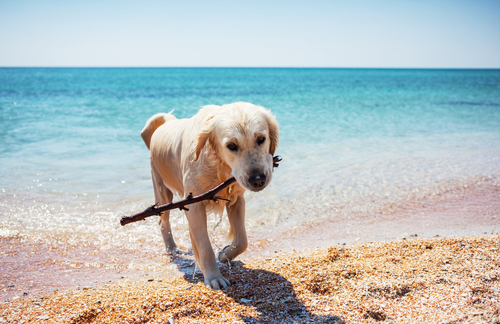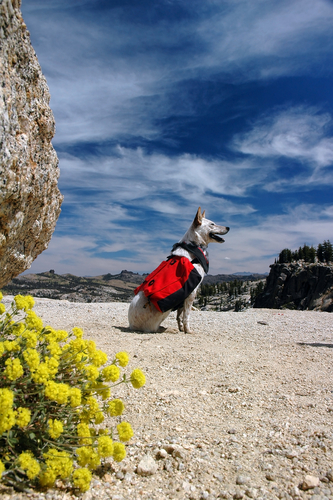Summer is here! That means road trips, hikes, swimming, and so much more! Summer often means more free time, and that means more free time with our dogs! It’s pretty obvious that dogs love going outside, and summer gives us the beautiful weather to explore the great outdoors. Whether it’s your local park or a backpacking trip with your four-legged pal, summer is the time for adventure. But with the freedom also comes a possibly dangerous component – heat. Being aware of the dangers of heat stroke is essential to keeping not just ourselves safe, but our dogs as well. In fact, heat is probably one of the biggest concerns active dog owners have regarding their pets. So what are some tips we can consider when prepping for our summer shenanigans?
- Acclimate your dogs to the heat. This is probably the most important step in ensuring that your dogs have a safe summer, and it’s perhaps the most overlooked. The first few weeks of heat are the most dangerous for our dogs, especially when they haven’t been exposed to the temperatures for some time. Remember that air conditioning is not always your friend! Just like you, your dogs need to adjust to the weather. As the temperatures start to change, start leaving your dog outside to relax in the heat. Always leave access to shade and water, of course. Laying out in the heat will greatly improve your dog’s ability to withstand it during activity. Moving to taking your dog out for short spurts in the sun and gradually increasing the activity, just as you would yourself, is key in getting your dog acclimated to the weather. Almost all dogs that suffer heat stroke were not properly acclimated to the heat, if at all.
- Exercise at the right times. Even with dogs that are fully acclimated to the weather, be mindful of when you choose to take them out. Training and working sessions should be kept short, if possible, if done during the warmest parts of the day. If you don’t have a working dog, or have the availability to train in the early morning or evening, it’s advised to hold your sessions then. Even the cooler parts of the day can still be fairly warm, and in the morning and evening you’ll have more freedom to find shade than during the stifling afternoon.
- Know the signs of heat stroke. Severe panting, lethargy, staggering, vomiting and/or diarrhea, and bright red gums and tongue are all signs of heat stroke. The most important thing to do is to get your dog to a veterinarian immediately. Helping to cool the dog’s stomach and bottoms of his feet, where he emits heatt from his body, will greatly help his outcome. But do not hesitate to get your dog help as soon as possible. Heat stroke is very real, and very dangerous. Left untreated, dogs will collapse and die very quickly. If you have your dog out in the heat, do not push him past his limits. Keep sessions short and pay close attention to his physical and mental signs that show he is getting tired.

- Understand how to properly keep your vehicle ventilated. This is important to understand because many of us have working, competition, and/or conformation dogs that must be left in the car during trials and events. It’s also important for pet owners to understand that this is not a complete death-trap. Dogs that have been properly acclimated to the heat and are worked and trained in it consistently will be safe in a ventilated vehicle on an average day. So how do we ensure that our dogs have the proper ventilation?
- Keep your dogs in crates or x-pens. This is important because a crated dog can have the windows all the way down on the vehicle without you having to worry about them escaping. For dogs that cannot be crated, using BreezeGuard Metal Screens can be useful. Many dog enthusiasts will use the BreezeGuard screens and keep their dogs in crates for extra security. These screens allow the windows to be all the way down with a barrier keeping the dogs in, while still enabling airflow. If your dogs are in crates, make sure the crates have proper ventilation as well. If you have a plastic crate that you think needs more ventilation, it’s very easy to drill more holes to allow more airflow to push through.
- Park in the shade. This means also keeping an eye on your car to make sure it stays in the shade. Obviously, it might be difficult to keep your car fully in the shade all day long at a busy event with hundreds of other vehicles. So with that, we suggest using window shades.
- Window shades can drastically reduce the temperature in your car. Keeping your windshield covered with a reflective shade and also covering your car our your dogs’ crates with Aluminet shade cloths will keep the temperature inside lower than the temperature outside. In fact, it’s been reported by many users that Aluminet shade cloths will keep the temperatures a solid 15-20º F cooler than outside temperatures.
- Use fans! In fact, a great fan goes a long way. There are a number of crate fans available on the market, but the more dog events I go to, the more I see people using the Ryobi fans. These fans are a little pricy, but they push a lot of air through and make a huge difference in lowering the temperature. Even when left on the high speed, they’ve been known to run a solid 2-3 hours on one battery. That means you’ll only need two or three batteries per day if you’re at a long trial or event.
- Consider Vent-Locks if you have any sort of SUV, truck, van, or hatchback vehicle. These things are a favorite for dog enthusiasts and make a huge difference in the airflow that’s pushed through the vehicle. They come in a number of sizes and are perfect for keeping doors and windows cracked open. The great thing about these is that they lock when your vehicle locks, so that the opening only stays the length of the Vent-Lock and passerby’s can’t get into your vehicle.
- Water. Access to water is important, even if your dogs are left in the shade. There are tons of ways to leave water on the crate door of your dog’s box, and there’s really no reason that water shouldn’t be available. If it’s an exceptionally hot day, you can even fill and freeze large water bottles to put in your dog’s crate or pen to give him something cool to lay on.
- Realize that some days are too hot. Some days really are just too hot to leave dogs out even in a ventilated area. Choose your training times and sessions wisely, and make it a point only to keep your dogs out as long as they need to be. If you have errands to run before or after a big event, it’s best to make sure you get your dogs home first where they can safely relax.
Since we’re on the subject of leaving dogs in vehicles or pens during a hot day, it’s important to remember that there is a difference between a ventilated vehicle and one with the windows barely cracked, sitting in the sun in a shopping center in the desert. There are many pictures going around social media websites showing seemingly distressed dogs in hot cars, with comments made by many that they’ll break the windows and release the dog. Yes! An unventilated car left in the sun with a dog will absolutely result in a terrible situation. That isn’t being denied. But it’s important to assess the entire situation. If the car is ventilated, the dog has shade, water, and airflow and does not look distressed (note – panting does not necessarily mean distressed), it’s probably fine. Instead of peering into the vehicle, talking to the dog, and/or trying to break into the car – simply go into the businesses in the area and ask the manager to page the owner. Talking to the dog or trying to break in the vehicle does not only further stress the dog (which can greatly increase the damage of any heat stroke), it can also get you injured. If you can’t find the owner of the vehicle, it’s okay to call the police. Do not take it upon yourself to free the dog. We know that you want to do the right thing, but it cannot be stressed enough how important it is to leave the dog alone. You WILL upset the dog and it will increase the damage done to the dog incredibly.
With all of this, you should be well set to bring your dog out in the summer heat and have some great, safe fun. So remember to acclimate your dog, provide with the essential shade, water and ventilation, and know the signs of heat stroke. Stop your training or playing if you think your dog is showing any signs of weakness, or take a few days off if you think the weather is just too hot. But most importantly, remember to have fun! Summer is the time for beaches, hikes, dog trials and shows! If you have more time and you’ve been thinking about trying out agility or flyball, go out and do it! The weather is great, the daylight is longer, and your dog is ready to have fun!
Katie is a professional dog trainer located in Southern California, with a background of experience as a veterinary assistant as well. She has trained and competed with multiple breeds in AKC Obedience and Rally, agility, herding, Schutzhund/IPO, French Ring and conformation. She has been involved in dogs since she was a child, and specializes in protection dogs, working dogs, and aggression issues. You can visit her website, Katie’s Dog Training, to find out more information about her training and accomplishments. When she’s not helping others and writing, she’s out on the field with her Belgian Malinois and Pembroke Welsh Corgi.

 Toledo, United States.
Toledo, United States.